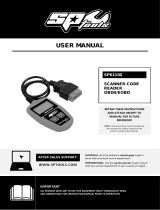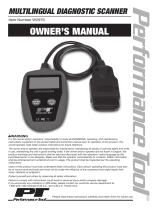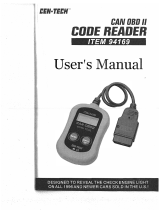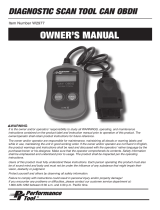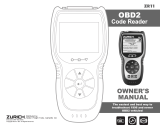Page is loading ...


CHECK
OWNER S MANUAL
,
OBD2 CODE READER
2
Table Of Contents
1. INTRODUCTION
1.1 About OBD2 Code Reader----------------------------------------------------------3
1.2 Safety Precautions and Warnings--------------------------------------------------3
2. GENERAL INFORMATION
2.1 On-Board-Diagnostics (OBD) 2------------------------------------------------------4
2.2 Diagnostic Trouble Codes (DTCS) ------------------------------------------------5
2.3 Location Of the Data Link Conector (DLC) ------------------------------------6
2.4 OBD2 Readiness Monitors -----------------------------------------------------------6
2.5 OBD2 Monitor Readiness Status---------------------------------------------------8
2.6 OBD2 Terminology-----------------------------------------------------------------------8
3. PRODUCT INFORMATION
3.1 Tool Descri ption --------------------------------------------------------------------------10
3.2 Product Specifications -----------------------------------------------------------------10
3.3 Product Features-------------------------------------------------------------------------10
3.4 Vehicle Coverage ------------------------------------------------------------------------11
4. OPERATING INSTRUCTIONS
4.1 Reading Codes ---------------------------------------------------------------------------12
4.2 Erasing Codes----------------------------------------------------------------------------14
4.3 Retrieving I/M Readiness Status --------------------------------------------------15
4.4 Viewing VIN Number--------------------------------------------------------------------17
4.5 Rescanning Data-------------------------------------------------------------------------17
5. DIAGNOSTIC TROUBLE CODE (DTC) DEFINITIONS
5.1 OBD2 Generic DTC Definitions-----------------------------------------------------18
5.2 Part Of OBD2 Manufacturer Specific DTC Definitions -------------------47
6. WARRANTY AND SERVICE
6.1 Limited One Year Warranty ----------------------------------------------------------55
6.2 Service Procedures --------------------------------------------------------------------55

CHECK
OWNER S MANUAL
,
OBD2 CODE READER
3
1. INTRODUCTION
1.1 About OBD2 Code Reader
This powerful tool will help you take charge of your vehicle's
maintenance and servicing needs. Today vehicles use Computer Control
Systems to ensure peak per-formance and fuel-efficiency while reducing
pollutants in the vehicle's emissions. These systems also have the
ability to perform self-testing and diagnose various vehicle systems and
components, and provide valuable information to aid in servicing and
repair. However, these sophisticated systems often required expensive
tools and test equi pment in order to retrieve this information. Until now,
consumers had to rely on professional service technicians to maintain their
vehicles in top condition.
OBD2 Code Reader brings the power of the technician into your hands
in a cost-effective, easy-to-use package. Whether you are a“"put the
key in and go"”consumer, hobby mechanic or skilled DIYer, Code Reader
offers the features and functions you need to take control of your vehicle's
testing, servicing and maintenance needs.
1.2 Safety Precautions and Warnings
To prevent personal injury or damage to vehicles and/or the Scan
Tool, read this instruction manual first and observe the following safety
precautions at a minimum whenever working on a vehicle:
1. Always perform automotive testing in a safe environment.
2. Wear safety eye protection that meets ANSI standards.
3. Keep clothing, hair, hands, tools, test equi pment, etc, away from all moving
or hot engine parts.
4. Operate the vehicle in a well-ventilated work area; Exhaust gases are
poisonous.
5. Put blocks on drive wheels and never leave vehicle unattended while
running tests.

CHECK
OWNER S MANUAL
,
OBD2 CODE READER
4
6. Use extreme caution when working around the ignition coil, distributor
cap, ignition wires and spark plugs. These components create hazardous
voltages when the engine is running.
7. Put transmission in PARK (for automatic transmission) or NEUTRAL (for
manual transmission) and make sure the parking break is engaged.
8. Keep a fire extinguisher suitable for gasoline/chemical/electrical fires
nearby.
9. Don't connect or disconnect any test equi pment with ignition on or
engine running.
10. Keep the Scan Tool dry, clean and free from oil, water and grease.
Use a mild detergent on a clean cloth to clean the outside of the Scan
Tool, when necessary.
2. GENERAL INFORMATION
2.1 On-Board-Diagnostics (OBD) 2
The first generation of On-Board Diagnostic (called OBD I) was
developed by the California Air Resources Board (ARB) and implemented
in 1988 to monitor some of the emission control components on vehicles.
As technology and the desire to improve On-Board Diagnostic capability
increased, a new generation of On-Board Diagnostics system was
developed. This second generation of On-Board Diagnostic regulations is
called "OBD II".
The OBD II system is designed to monitor emission control systems
and key engine components by performing either continuous or periodic
tests of specific components and vehicle conditions. When a problem is
detected, the OBD II system turns on a warning lamp (MIL) on the vehicle
instrument panel to alert the driver typically by the phrase of "Check
Engine" or "Service Engine Soon". The system will also store important
information about the detected malfunction so that a technician can

CHECK
OWNER S MANUAL
,
OBD2 CODE READER
5
accurately find and fix the problem. Here below follow three pieces of
such crucial information:
Whether the Malfunction Indicator Light (MIL) is commanded 'on' or
'off';
Which, if any, Diagnostic Trouble Codes (DTCs) are stored;
Readiness Monitor status.
2.2 Diagnostic Trouble Codes (DTCs)
OBDII Diagnostic Trouble Codes are stored by the on-board computer
diagnostic system in response to a problem found in the vehicle. These
codes identify a particular problem area and are intended to provide you
with a guide as to where a fault mig ht be occurring within a vehicle. OBDII
Diagnostic Trouble Codes consist of a five-digit alphanumeric code. The
first character, a letter, identifies which control system sets the code. The
other four characters, all numbers, provide additional information on where
the DTC originated and the operating conditions that caused it to set. Here
below is an example to illustrate the structure of the digits:

CHECK
OWNER S MANUAL
,
OBD2 CODE READER
6
Systems
B=Body
C=Chassis
P=Powertrain
U=Network
Identifies what section
of the systems is
malfunctioning
Code Type
Generic (SAE):
P0, P2, P34-P39
B0, B3
C0, C3
U0, U3.
Manufacturer Specific:
P1, P30-p33
B1, B2
C1, C2
U1, U2
Sub-systems
1= Fuel and Air Metering
2= Fuel and Air Metering
3= Ignition System or Engine Misfire
4= Auxiliary Emission Controls
5= Vehicle Speed Control and Idle
Controls
6= Computer Output Circuits
7= Transmission Controls
8= Transmission Controls
P 0 2 0 1
DTC Example
2.3 Location of the Data Link Connector (DLC)
The DLC (Data Link Connector or Diagnostic Link Connector) is the
standardized 16-cavity connector where diagnostic scan tools interface
with the vehicle's on-board computer. The DLC is usually located 12
inches from the center of the instrument panel (dash), under or around
the driver's side for most vehicles. For some Asian and European vehicles,
the DLC is located behind the ashtray and the ashtray must be removed
to access the connector. Refer to the vehicle's service manual for the
location if the DLC can not be found.
2.4 OBD II Readiness Monitors
An important part of a vehicle's OBDII system is the Readiness
monitors, which are indicators used to find out if all of the emissions

CHECK
OWNER S MANUAL
,
OBD2 CODE READER
7
components have been evaluated by the OBD II system. They are running
periodic tests on specific systems and components to ensure that they
are performing within allowable limits.
Currently, there are eleven OBD II Readiness Monitors (or I/M Monitors)
defined by the U.S. Environmental Protection Agency (EPA). Not all
monitors are supported by all vehicles and the exact number of monitors
in any vehicle depends on the motor vehicle manufacturer's emissions
control strategy.
Continuous Monitors -- Some of the vehicle components or systems
are continuously tested by the vehicle's OBDII system, while others are
tested only under specific vehicle operating conditions. The continuously
monitored components listed below are always ready:
1. Misfire
2. Fuel System
3. Comprehensive Components (CCM)
Once the vehicle is running, the OBDII system is continuously checking the
above components, monitoring key engine sensors, watching for engine
misfire, and monitoring fuel demands.
Non--Continuous Monitors -- Unlike the continuous monitors,many
emissions and engine system components require the vehicle to be
operated under specific conditions before the monitor is ready. These
monitors are termed non-continuous monitors and are listed below:
1. EGR System
2. O2 Sensors
3. Catalyst
4. Evaporative System
5. O2 Sensor Heater
6. Secondary air
7. Heated Catalyst
8. A/C system

CHECK
OWNER S MANUAL
,
OBD2 CODE READER
8
2.5 OBD II Monitor Readiness Status
OBD II systems must indicate whether or not the vehicle's PCM monitor
system has completed testing on each component. Components that have
been tested will be reported as Ready, or Complete, meaning they have
been tested by the OBD II system. The purpose of recording readiness
status is to allow inspectors to determine if the vehicle's OBD II system
has tested all the components and/or systems.
The powertrain control module (PCM) sets a monitor to"Ready"
or“"Complete" after an appropriate drive cycle has been performed. The
drive cycle that enables a monitor and sets readiness codes to ready”
varies for each individual monitor. Once a monitor is set as“"Ready"
or "Complete", it will remain in this state. A number of factors, including
erasing of diagnostic trouble codes (DTCs) with a scan tool or a
disconnected battery, can result in Readiness Monitors being set to "not
ready". Since the three continuous monitors are constantly evaluating,
they will be reported as "Ready"”all of the time. If testing of a particular
supported non-continuous monitor has not been completed, the monitor
status will be reported as "Not Complete" or "Not Ready".”
In order for the OBD monitor system to become ready, the vehicle should
be driven under a variety of normal operating conditions. These operating
conditions may include a mix of hig hway driving and stop and go, city
type driving, and at least one overnig ht-off period. For specific information
on getting your vehicle's OBD monitor system ready, please consult your
vehicle owner's manual.
2.6 OBD II Definitions
Powertrain Control Module (PCM)--OBDII terminology for the on-
board computer that controls engine and drive train.

CHECK
OWNER S MANUAL
,
OBD2 CODE READER
9
Malfunction Indicator Light (MIL)--Malfunction Indicator Lig ht (Service
Engine Soon, Check Engine) is a term used for the lig ht on the instrument
panel. It is to alert the driver and/or the repair technician that there is a
problem with one or more of vehicle's systems and may cause emissions
to exceed federal standards. If the MIL illuminates with a steady lig ht, it
indicates that a problem has been detected and the vehicle should be
serviced as soon as possible. Under certain conditions, the dashboard
lig ht will blink or flash. This indicates a severe problem and flashing is
intended to discourage vehicle operation. The vehicle on-board diagnostic
system can not turn the MIL off until the necessary repairs are completed
or the condition no longer exists.
DTC--Diagnostic Trouble Codes (DTC) that identify which section of the
emission control system has malfunctioned.
Enabling criteria--Also termed Enabling Conditions. They are the vehicle-
specific events or conditions that must occur within the engine before the
various monitors will set, or run. Some monitors require the vehicle to follow
a prescribed "drive cycle" routine as part of the enabling criteria. Drive
cycles vary among vehicles and for each monitor in any particular vehicle.
OBDII Drive Cycle--A specific mode of vehicle operation that provides
condition required to set all the readiness monitors applicable to the vehicle
to the "ready" condition. The purpose of completing an OBD II drive cycle
is to force the vehicle to run its on-board diagnostics. Some form of a
drive cycle needs to be performed after DTCs have been erased from
the PCM's memory or after the battery has been disconnected. Running
throug h a vehicle's complete drive cycle will "set" the readiness monitors
so that future faults can be detected. Drive cycles vary depending on the
vehicle and the monitor that needs to be reset. For vehicle specific drive
cycle, consult the vehicle's Owner's Manual.

CHECK
OWNER S MANUAL
,
OBD2 CODE READER
10
1.LCD DISPLAY--Indicates test results. It is a backlit 2-line display with 8
characters on each line.
2. ENTER BUTTON--Confirms a selection (or action) from a menu list, or
returns to the main menu.
3.SCROLL BUTTON--Scrolls throug h menu items or cancel an operation
4.OBD II CONNECTOR--Connects the Code Scanner to the vehicle's
Data Link Connector (DLC).
3.2 Product Specifications
1. Display: LCD, 2 lines, 8 characters, backlit
2. Operating Temperature: 0 to 50°C (-32 to 122 F°)
3. Storage Temperature: -20 to 70°C (-4 to 158 F°)
4. Power—provided via detachable heavy duty OBD II cable
5. Dimensions:
Length Width Heig ht
126 mm ( 5.0”) 78 mm ( 3.2”) 28mm (0.85”)
6. Weig ht: 200g (7.12 oz)
1
2
4
3
3. PRODUCT INFORMATION
3.1 Tool Description

CHECK
OWNER S MANUAL
,
OBD2 CODE READER
11
3.3 Product Features
1. Works with all 1996 and newer cars & trucks that are OBD II compliant
(including the CAN, VPW, PWM, ISO and KWP 2000).
2. Reads and clears generic and manufacturer specific Diagnostic Trouble
Codes (DTCs) and turns off check engine lig ht.
3. Supports multi ple trouble code requests, generic codes, pending codes
and manufacturers' specific codes.
4. Reviews the emission readiness status of OBD monitors.
5. Retrieves VIN (Vehicle Identification No.) on 2002 and newer vehicles
that support Mode 9.
6. Determines the malfunction indicator lamp (MIL) status.
7. Easy-to-use with one plug-in; Hig hly reliable and accurate.
8. Easy-to-read crystal-clear backlit 2-line LCD display.
9. Stand-alone unit with no need for an additional laptop computer to
operate.
10. Small in size and conveniently fits in your palm.
11. Safely communicates with the on-board computer.
12. No batteries needed--powered via detachable OBD II cable.
3.4 Vehicle Coverage
The T40e OBD II Scan Tool is specially designed to work with all OBDII
compliant vehicles, including those equi pped with the next-generation
protocol-Control Area Network (CAN). It is required by EPA that All 1996
and newer vehicles (cars and lig ht trucks) sold in the United States must
be OBD II compliant and this includes all Domestic, Asian and European
vehicles.
A small number of 1994 and 1995 model year gasoline vehicles are
OBD II compliant. To verify if a 1994 or 1995 vehicle is OBD II compliant,
check the Vehicle Emissions Control Information (VECI) Label which is
located under the hood or by the radiator of most vehicles. If the vehicle

CHECK
OWNER S MANUAL
,
OBD2 CODE READER
12
4. Operating Instructions
4.1 Reading Codes:
CAUTION: Don,t connect or disconnect any test equi pment with ignition on
or engine running.
1) Turn the ignition off.
2) Locate the 16-pin Data Link Connector (DLC) and plug into the
Scan Tool cable connector to the DLC.
3) Wait for the LCD display to read C. A. N. OBD2.
C .A. N.
OBD2
SCAN...…
VPW
SCAN...…
PWM
SCAN...…
ISO9141
SCAN...…
CAN
SCAN...…
KWP 2000
4) Turn the ignition on. But do not start the engine.
5) Press the ENTER button. A sequence of messages showing the OBD
protocols may be observed on the display until the vehicle protocol is
detected.
Not all the above messages will be observed unless the protocol used
by the vehicle being tested is the last one—the ISO9141 protocol. They will
stop appearing after the vehicle protocol is detected and a confirmation
message of XXX Protocol is displayed.
is OBD II compliant, the label will designate“"OBD II Certified". Additionally,
Government regulations mandate that all OBD II compliant vehicles must
have a "common" sixteen- pin Data Link Connector (DLC).
For your vehicle to be OBD II compliant, it must have a 16-pin DLC
(Data Link Connector) under the dash and the Vehicle Emission Control
Information Label must state that the vehicle is OBD II compliant.

CHECK
OWNER S MANUAL
,
OBD2 CODE READER
13
DTC
06
I/M
YES
Menu:
1. DTC
NO
CODES
FAULT: 03
PEND: 03
If a "LINK ERROR!" message shows up, turn the ignition off for
about 10 seconds, check if the Scan Tool's OBDII connector is securely
connected to the vehicle s DLC, and then turn the ignition back to on.
Repeat the procedure from step 5. If the "LINK ERROR" message
does not go away, then there may be problems for the Scan Tool to
communicate with the vehicle.
6) Wait for the main menu to come up after a brief overview displaying
the scanning results with the total number of DTCs and the overall I/M
Monitor Status.
7) Select "DTC" from the main menu by pressing the ENTER button.
If there are no Diagnostic Trouble Codes retrieved, the display will
indicate "NO CODES".
If there are any Diagnostic Trouble Codes, then the total number of the
Fault Codes followed by that of the Pending Codes will be reported on the
display.
8) Read the Diagnostic Trouble Codes by pressing the SCROLL button.
The first code number will display on the first line of the LCD display,
the numerical sequence of the code and the total number of the codes

CHECK
OWNER S MANUAL
,
OBD2 CODE READER
14
P0101
01/04
P0005 PD
01/05
Menu:
2. ERASE
If the code retrieved is a pending code, a "PD"”will show on the LCD
display in the end.
To view previous codes, press the SCROLL button to scroll throug h to
the end, and then start from the first of the list.
9) Look up part 5 for Diagnostic Trouble Code Definitions. Match the
retrieved DTC(S) with those listed and read the definitions.
4.2 Erasing Codes:
CAUTION: Erasing the Diagnostic Trouble Codes allows the Scan Tool to
delete not only the codes from the vehicle's on-board computer, but also
"Freeze Frame" data and manufacturer specific enhanced data. Further,
the I/M Readiness Monitor Status for all vehicle Monitors is reset to "Not
Ready" or "Not Complete" status. Do not erase the codes before the
system has been checked completely by a technician.
1) If you decide to erase the DTCs, Select "2. ERASE" from the main
menu by pressing the ENTER button.
If the Scan Tool is not connected or no communication is established with
the vehicle yet, then refer to "Reading Codes"”from 1 to 6. at Paragraph 4.1.
stored will appear on the second line. To view additional codes, press
the SCROLL button to scroll, as necessary, until all the codes have been
shown up.

CHECK
OWNER S MANUAL
,
OBD2 CODE READER
15
ERASE
DONE!
ERASE
FAIL!
ERASE?
YES NO
3) If you do not want to proceed with erasing the codes, press the
SCROLL button to exit.
4) If you do wish to proceed to erase the codes, then press the ENTER
button.
5) If the codes are cleared successfully, an "ERASE DONE!"”message
will show on the display. Press the ENTER button to Return to the main
Menu list.
6) If the codes are not cleared, then an "ERASE FAIL!" message will
appear. Press the ENTER button to Return to the main Menu list.
HOT KEY: Pressing and Holding the SCROLL button for about 3
seconds will allow you to more quickly erase the DTCs than throug h the
main menu.
4.3 RETRIEVING I/M READINESS STATUS:
Important: I/M Readiness function is used to check the operations of the
Emission System on OBD2 compliant vehicles. It is an excellent function to
use prior to having a vehicle inspected for compliance to a state emissions
program. An I/M Readiness Status result of "NO" does not necessarily
indicate that the vehicle being tested will fail the state I/M inspection. For
2) A message of "ERASE? YES NO"”comes up asking for your
confirmation.

CHECK
OWNER S MANUAL
,
OBD2 CODE READER
16
" " --A flashing Rig ht Arrow Indicating additional information is
available on the next screen.
" " --A flashing Left Arrow Indicating additional information is available
on the previous screen.
1) Select "3. I/M"”from the main menu by pressing the ENTER button.
some states, one or more such monitors may be allowed to be“"Not
Ready" to pass the emissions inspection.
"YES"”--All monitors supported on the vehicle have completed their
diagnostic testing and the MIL lig ht is not on.
"NO"--At least one monitor supported on the vehicle has not completed
its diagnostic testing, and (or) the Check Engine ( MIL) lig ht is on.
"READY"--indicates that a particular monitor being checked has
completed its diagnostic testing;
"Not RDY(NOT READY)"--indicates a particular monitor being checked
has not completed its diagnostic testing;
"N/A"--The monitor is not supported on that vehicle.
Menu:
3. I/M
If the Scan Tool is not connected yet, then refer to " Reading Codes"
from 1 to 6. at Paragraph 4.1.
2) Use the SCROLL button to view the status of the MIL lig ht ("ON" or
"OFF") and the following monitors:
MISFIRE"--Misfire monitor
FUEL--Fuel System Monitor
CCM--Comprehensive Components Monitor
EGR--EGR System Monitor
O2S--O2 Sensors Monitor
AT--Catalyst Monitor

CHECK
OWNER S MANUAL
,
OBD2 CODE READER
17
Menu:
4. VIN
EVAP--Evaporative System Monitor
HO2S--O2 Sensor Heater Monitor
2AIR-- Secondary Air Monitor
HCM--Heated Catalyst Monitor
A/C--A/C system Monitor
3) Press the ENTER button to return to the main Menu.
4.4 Viewing VIN Number
The View VIN function allows you to view the Vehicle Identification No. on
2002 and newer vehicles that support Mode 9.
1) Select 4. VIN”from the main menu by pressing the ENTER button.
If the Scan Tool is not connected yet, then refer to "Reading
Codes"”from 1 to 6. at Paragraph 4.1.
2). Use the SCROLL button to view additional digits of the 17-digit string.
" "-- A flashing Rig ht Arrow Indicating additional digits of VIN string
are available on the next screen.
" "-- A flashing Left Arrow Indicating additional digits of VIN string
are available on the previous screen.
3) Press the ENTER button to return to the main Menu.
4.5 Rescanning Data
The RESCAN function allows you to retrieve the most current data stored
in the ECM or to re-link to the vehicle.
if communication is disconnected.
1) Select "5. RESCAN" from the main menu by pressing the ENTER
button.

CHECK
OWNER S MANUAL
,
OBD2 CODE READER
18
Menu:
5.RESCAN
If the Scan Tool is not connected yet, then refer to "Reading
Codes"”from 1 to 6. at Paragraph 4.1.
2) Use either the SCROLL or ENTER button to return to the main menu.
5. Diagnostic Trouble Code (DTC)
Definitions
The following Diagnostic Trouble Code Definitions lists provide Generic
Diagnostic Trouble Codes, and Manufacturer Specific Diagnostic Trouble
Code Definitions for CHRYSLER and TOYOTA only. others consult the
vehicle’s service manual or the enclosed CD software.
CAUTION: Parts or components should not be replaced based on only a
DTC without first consulting the vehicle service manual for more information
on possible causes of the fault as well as required testing procedures.
5.1 OBDII Generic DTC Definitions
P0001 Fuel Volume Regulator Control Circuit Open
P0002 Fuel Volume Regulator Control Circuit Range/Performance
P0003 Fuel Volume Regulator Control Circuit Low
P0004 Fuel Volume Regulator Control Circuit Hig h
P0005 Fuel Shutoff Valve. A Control Circuit Open
P0006 Fuel Shutoff Valve. A Control Circuit Low
P0007 Fuel Shutoff Valve. A Control Circuit Hig h
P0008 Engine Position System Performance (Bank 1)
P0009 Engine Position System Performance (Bank 2)
P0010 Camshaft Position Actuator A -Bank 1 Circuit Malfunction
P0011 Camshaft Position Actuator A -Bank 1 Timing Over-Advanced
OBDII Generic DTC Definitions

CHECK
OWNER S MANUAL
,
OBD2 CODE READER
19
P0012 Camshaft Position Actuator A - Bank 1 Timing Over-Retarded
P0013 Camshaft Position Actuator B - Bank 1 Circuit Malfunction
P0014 Camshaft Position Actuator B - Bank 1 Timing Over-Advanced
P0015 Camshaft Position Actuator B - Bank 1 Timing Over-Retarded
P0016 Cam/Crankshaft Pos. Correlation Sensor A - Bank 1
P0017 Cam/Crankshaft Pos. Correlation Sensor B - Bank 1
P0018 Cam/Crankshaft Pos. Correlation Sensor A - Bank 2
P0019 Cam/Crankshaft Pos. Correlation Sensor B - Bank 2
P0020 Camshaft Position Actuator A - Bank 2 Circuit Malfunction
P0021 Camshaft Position Actuator A - Bank 2 Timing Over-Advanced
P0022 Camshaft Position Actuator A - Bank 2 Timing Over-Retarded
P0023 Camshaft Position Actuator B - Bank 2 Circuit Malfunction
P0024 Camshaft Position Actuator B - Bank 2 Timing Over-Advanced
P0025 Camshaft Position Actuator B - Bank 2 Timing Over-Retarded
P0026 Intake Valve-Bank 1 Control Solenoid CKT Range/Performance
P0027 Exhaust Valve-Bank1 Control Solenoid CKT Range/Performance
P0028 Intake Valve-Bank 2 Control Solenoid CKT Range/Performance
P0029 Exhaust Valve-Bank2 Control Solenoid CKT Range/Performance
P0030 HO2S Bank 1 Sensor 1 Heater Circuit
P0031 HO2S Bank 1 Sensor 1 Heater Circuit Low
P0032 HO2S Bank 1 Sensor 1 Heater Circuit Hig h
P0033 Turbo/Sup Wastegate Control Circuit
P0034 Turbo/Sup Wastegate Control Circuit Low
P0035 Turbo/Sup Wastegate Control Circuit Hig h
P0036 HO2S Bank 1 Sensor 2 Heater Circuit
P0037 HO2S Bank 1 Sensor 2 Heater Circuit Low
P0038 HO2S Bank 1 Sensor 2 Heater Circuit High
P0039 Turbo/Super Charger Bypass Control CKT Performance
P0040 O2 Bank 1 Sensor 1 Signals Swapped w/ O2 Bank 2 Sensor 1
P0041 O2 Bank 1 Sensor 2 Signals Swapped w/ O2 Bank 2 Sensor 2
P0042 HO2S Bank 1 Sensor 3 Heater Circuit
P0043 HO2S Bank 1 Sensor 3 Heater Circuit Low
P0044 HO2S Bank 1 Sensor 3 Heater Circuit Hig h
P0045 Turbo/Super Charger Boost Control Solenoid A Circuit Open
P0046 Turbo/Super Charger Boost Control Solenoid A Circuit Range/ Perform
P0047 Turbo/Super Charger Boost Control Solenoid A Circuit Low
OBDII Generic DTC Definitions

CHECK
OWNER S MANUAL
,
OBD2 CODE READER
20
P0048 Turbo/Super Charger Boost Control Solenoid A Circuit High
P0049 Turbo/Super Charger Boost Input/Turbine Speed Overspeed
P0050 HO2S Bank 2 Sensor 1 Heater Circuit
P0051 HO2S Bank 2 Sensor 1 Heater Circuit Low
P0052 HO2S Bank 2 Sensor 1 Heater Circuit Hig h
P0053 HO2S Bank 1 Sensor 1 Heater Resistance
P0054 HO2S Bank 1 Sensor 2 Heater Resistance
P0055 HO2S Bank 1 Sensor 3 Heater Resistance
P0056 HO2S Bank 2 Sensor 2 Heater Circuit
P0057 HO2S Bank 2 Sensor 2 Heater Circuit Low
P0058 HO2S Bank 2 Sensor 2 Heater Circuit Hig h
P0059 HO2S Bank 2 Sensor 1 Heater Resistance
P0060 HO2S Bank 2 Sensor 2 Heater Resistance
P0061 HO2S Bank 2 Sensor 3 Heater Resistance
P0062 HO2S Bank 2 Sensor 3 Heater Circuit
P0063 HO2S Bank 2 Sensor 3 Heater Circuit Low
P0064 HO2S Bank 2 Sensor 3 Heater Circuit Hig h
P0065 Air Assisted Injector. Control Range/Performance
P0066 Air Assisted Injector. Control Circuit Low
P0067 Air Assisted Injector. Control Circuit Hig h
P0068 MAF/MAP Sensor Throttle Position Correlation
P0069 MAP/BARO Correlation
P0070 Ambient Air Temp. Sensor Circuit
P0071 Ambient Air Temp. Sensor Range/Performance
P0072 Ambient Air Temp. Sensor Circuit Low
P0073 Ambient Air Temp. Sensor Circuit Hig h
P0074 Ambient Air Temp. Sensor CKT Intermittent
P0075 Intake Valve-Bank 1 Control Circuit
P0076 Intake Valve-Bank 1 Control Circuit Low
P0077 Intake Valve-Bank 1 Control Circuit Hig h
P0078 Exhaust Valve-Bank1 Control Circuit
P0079 Exhaust Valve-Bank1 Control Circuit Low
P0080 Exhaust Valve-Bank1 Control Circuit High
P0081 Intake Valve-Bank 2 Control Circuit
P0082 Intake Valve-Bank 2 Control Circuit Low
P0083 Intake Valve-Bank 2 Control Circuit Hig h
OBDII Generic DTC Definitions
/
